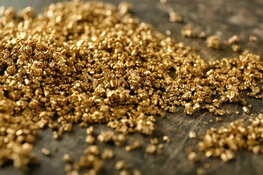It's all quite understandable, as many people see gold as a haven from global turmoil. Poland's new prime minister certainly does and has been buying so much that the country's president accused him of trying to usurp the power of the country's central bank.
Last December, his acquisitions and U.S. inflation pushed the price of the metal up to an all-time high of US$2,135.39/oz. Perhaps his approach makes sense, given his country's proximity to the current conflict, but it also paints a large target for would-be invaders like Russia.
The move and resulting kerfuffle reflect the fractious nature of economic politics in the country under the rule of a new centrist coalition headed by former Prime Minister and ex-president of the European Council, Donald Tusk. Current central bank governor Adam Glapiński is an ally of the right-wing Law and Justice Party (PiS), which lost power in October.
However, (most) banks and governments worldwide seem to agree that gold offers a bright and turbulence-free path to future national prosperity. Hence, the historically inflated price.
"While Glapiński should be at the vanguard of those who protect the political neutrality of the National Bank of Poland, we note that he has failed this test," Tusk explained last year.
National President Andrzej Duda stated at the time that he does "not agree with all those who criticize the Monetary Policy Council and the governor of the NBP" while criticizing Tusk's shutdown of state-owned media, which the new Prime Minister claims became too politicized under the PiS.
Tusk then removed PiS-appointee Jacek Kurski as Poland's representative to the World Bank, and the bank responded with a press release characterizing the move as unlawful and threatened to remove Glapiński as central bank governor but never followed through. The prime minister also expressed a desire to prosecute the bank governor for "unlawful" quantitative easing.
Christine Lagarde, the chief central banker of the neighboring Eurozone, wrote Glapiński, concurring that EU member-state bankers should be protected against political interference affecting their independence. Tusk disagrees, arguing, "All the measures we will take, including concerning Glapiński, are aimed at rebuilding the full political independence of the central bank."
To Acquire, Hold or Divest? The Timeless Quandary
The relationships between national leaders and central banks have always been tenuous. Reserves, especially gold reserves, are always a point of contention, especially in how their sizes relate to lending rates. Bankers and politicians have different concepts of what "stability" looks like.
However, (most) banks and governments worldwide seem to agree that gold offers a bright and turbulence-free path to future national prosperity. Hence, the historically inflated price.
How nations approach this specific hard asset class varies significantly. The U.S., for example, has long held tons of deep storage and working stock gold scattered across the country (brashly listing the locations publicly in the Treasury-Owned Gold Dataset.)
The weight of gold in troy ounces (still used today for weighing precious metals and gunpowder) is listed, as well as the "book value" in "dollars." This value is not close to the market rate but rather the total number of troy ounces multiplied by the US$42.222/oz value established by law in 1973.
Canada, on the other hand, has completely divested from its once considerable holdings. The country's gold reserves exceeded 1000 tons in the 1960s, but modern holdings averaged 6.15 tons from 2000 until 2023, reaching a peak of 46.20 tons in the first quarter of 2000. They were entirely depleted by the first quarter of 2016.
Reuters reported in January last year that central banks bought the most gold on record (1,136 tons of gold worth some US$70 billion) in the previous year.
The country hasn't re-entered the market since. This stance may seem odd, but one should remember that Canada still has some of the world's most significant gold reserves in the ground.
Reporting at the time the government sold off the final ton, CBC journalist Pete Evans explained that "Ottawa still [had] 77 ounces of gold, worth about CA$130,000 at current market prices. All of that consists of gold coins, as opposed to large bullion bricks that the government once hoarded."
"The decision to sell the gold was not tied to a specific gold price, and sales are being conducted over a long period and in a controlled manner," wrote Department of Finance spokesman David Barnabe. "The government has a long-standing policy of diversifying its portfolio by selling physical commodities (such as gold) and instead investing in financial assets that are easily tradable and that have deep markets of buyers and sellers."
The Royal Canadian Mint has produced and banked pure gold Maple Leaf coins in various denominations since 1979, as well as CA$5 and CA$10 gold coins from 1912 to 1914. Thirty thousand pieces of that vintage numismatic gold were sold at a markup between 2012 and 2014, comprising some 13,000 ounces of gold. The remaining hoard was then refined for fast liquidation as bullion.
Former senior Department of Finance bureaucrat Don Drummond was upbeat at the time, expressing that it doesn't make any sense for Canada to hold gold because it historically hasn't delivered a reasonable rate of return but costs money to store. He opined that gold symbolized a country's wealth hundreds of years ago, but this is no longer true, as no significant currencies are still tied to the gold standard.
Canada was an outlier then, with Russia, India, and China leading the charge in adding to their hoards as Ottawa divested. As Canadian holdings reached zero, other central banks globally added roughly 336 tons to their reserves every two quarters, 25% more than they had the year before. At the time, the U.S. held 8,133 tons of gold, fully 72% of its reserves, with Germany (3,381 tons), France (>2,400 tons), and Italy (>2,400 tons) betting on the docile metal with more than 60% of their respective capital reserves.
Some European central banks with deep reserves did fractionally divest (to the tune of hundreds of tons a year) from 1993 into the early 2000s as the Treaty on European Union came into force, foisting much of the currency devaluation risk on the continent on new, supranational institutions and the newly-minted EU currency.
Modern Mania: Gold at (Almost) Any Price
In hindsight, Canada's complete divestment from physical assets may seem foolhardy. As mentioned, gold prices spiked considerably over the past decade, while Canada's economy has stagnated from inflationary gloom — precisely the type of economic misstep that physical gold may hedge against.
Other central banks haven't been quite as short-sighted. Reuters reported in January last year that central banks bought the most gold on record (1,136 tons of gold worth some US$70 billion) in the previous year. It seems everyone wants a strong inflation hedge, whatever that may cost.
Reeling from the financial crisis of 2008, European banks halted divestment as nascent economies like Russia, Turkey, and India started re-weighting their reserve portfolios heavily in favor of gold. Like bankers of old, they saw gold as a robust store of value through turbulent times that, unlike currencies and bonds, rely on no corporate issuer or government.
Poland bought a whopping 48.52 tons of Gold Over three Months, making the NBP officially the biggest central bank gold buyer in Q2 of last year.
"This is a continuation of a trend," explains World Gold Council (WGC) analyst Krishan Gopaul.
"You can see those drivers feeding into what happened last year [2022]. You had on the geopolitical front and the macroeconomic front a lot of uncertainty and volatility,"
While demand eased slightly during the outbreak of the coronavirus pandemic, it swelled again by Q3 of 2022, with central bank purchases totaling 862 tons in the second half of the year.
"Lower total reserves may constrain the capacity to add to existing allocations," according to the WGC, "But lagged reporting by some central banks means that we need to apply a high degree of uncertainty to our expectations, predominantly to the upside." Global demand in 2022, which includes new central bank acquisitions, was 4,741 tons, up 18% from 2021 and the highest for any year since 2011.
Poland: The New Big Buyer
That brings us up to August of 2023, when news broke that Poland bought a whopping 48.52 tons of Gold Over three Months, making the NBP officially the biggest central bank gold buyer in Q2 of last year, the first time in four years the Polish central bank has grown its reserves. This sudden and massive rebalancing put Poland in third place for total gold bought year-to-date as Q3 opened, behind China and Singapore.
China claims 57.85 tons bought in Q1 2023 and 45.1 in Q2, for a total of 102.95 tons year-to-date. Singapore claims 68.74 tons and 3 tons in Q1 and Q2, respectively, for a YTD influx of 71.71 tons, making it the largest central bank gold buyer for Q1 2023.
The IMF's International Financial Statistics Database tells the story, showing the NBP's holding of 228.62 tons in March of 2023, growing by 14.93 tons during April, 19.91 tons during May, and 13.69 tons during June, ending the quarter with 277.14 tons, a 21.2% increase that means gold which now represents 9.4% of Poland's reserves.
Remember that Poland uses the zloty as currency, so its inflation risk is not protected by the Eurozone. Indeed, the country bought another 125.7 tons of gold between 2018 and 2019 and communicated its rebalancing intentions in advance. It's not buying as much gold as fast as it claimed it would, with escalating prices probably putting something of a damper on those plans.
New buying by Poland's NBP during 2023 was only half of what was anticipated. NBP governor Glapińsk revealed his plan to buy 100 tons of gold during 2022 in 2021, expressing in October of that year that "in order to further increase Poland's financial security, we will continue the current policy, we will certainly strive to increase our gold resources."
"However, the scale and pace of purchases will depend, among others, on the dynamics of changes in official reserve assets and current market conditions. I initially assume that I will propose to buy another 100 tons in 2022." He initially floated the idea in March of 2021, telling Polish magazine Sieci, "Over a few years, we want to buy at least another 100 tons of gold and keep it in Poland as well."
On February 9, 2022, he made it official at a press conference, saying, "Only our own currency gives us the opportunity to conduct our own policy, which we consider to be the best for Poland's development. We can hoard gold, lots of gold. The increase in gold resources, the fact that we have 230 tons, has an extremely beneficial effect; investors view us differently; we are a reliable partner."
"I maintain that this year I intend to buy another 100 tons of gold, in a favorable situation, when it will be at the right time and in the right doses," he continued. "Despite the purchase of significant gold reserves in the recent period, the NBP has not yet said the last word on this matter."
Not Alone: Marginal European Economies Moving In Tandem
As you might expect, Poland is not the only marginal middle-European economy clamoring for more gold and the greater freedom that such reserve rebalancing grants both banks and nations. For example, in 2018, Hungary's central bank, the Magyar Nemzeti Bank (MNB), announced a 10x increase in its gold reserves.
Before the announcement, the bank held only 3.10 tons of gold. However, during the first two weeks of October, it purchased another 28.4, resulting in a 1000% increase in hoard size. Before this outsized purchase, the MNB hadn't rebalanced the gold allocation of its reserves for a whopping 32 years. The new total (31.5 tons) is roughly equal to the amount of gold the bank held 70 years ago. As in Poland, the new fever for acquisition seems partially rooted in a conservative desire to repatriate as much gold as was returned at the end of WWII.
This seemingly Sysiphian impulse is undoubtedly partially rooted in the hard physicality of gold, as illustrated in gushing articles rich with pictures documenting how Poland's newly acquired bars are being "airlifted to freedom."
Indeed, the MNB published a press release after its 10x rebalancing, claiming that "Following the substantial increase in the Bank's gold reserves in physical form, its repatriation has already taken place. The possession of precious metal within the country is in line with international trends, supports financial stability, and strengthens market confidence in Hungary."
"This size of holdings approaches the historical level that was held by our country at the time of the 'golden train,'" the release continues, "At the end of World War II, Hungary received some 30 tons of gold bars and gold coins on the MNB's legendary 'gold train' in the Spital am Pyhrn in Austria. This amount was fully returned to the country after the war while providing cover for the introduction of the new currency of the country, the Forint, thus supporting financial consolidation and the stabilization of the post-war Hungarian economy."
"At the time of the change of regime (between 1989 and 1992), the ruling central bank executives decided to reduce to a minimum level of about 3.1 tons, which was the level at the end of September 2018. With the decision of the MNB today in October 2018, the holdings of 31.5 tons of gold reserves is now the same as the level of the stabilization period of 1946."
According to the release, "The current decision of the Hungarian National Bank was led by the goal of stability, and there are no investment concerns behind the holding of gold reserves. Gold is not only for extreme market environments, structural changes in the international financial system, and deeper geopolitical crises. Gold also has a confidence-building effect in normal times; that is, gold can play a role in stabilizing and defending."
"Gold is still considered to be one of the world's safest assets," the MNB writes, "whose characteristics can be attributed to gold's unique properties such as finite supply of physical gold, and lack of credit and counterparty risk given that gold is not a claim against a specific partner or country."
"Over the past few years, more and more countries have decided to continue to play a decisive role in the use of gold as a traditional reserve asset, and have raised their gold reserves. This course of action was followed by Poland, in spite of the fact that Poland had already one of the highest gold reserves in the region."
"On the occasion of the announcement, the National Bank of Hungary has also published a 'Golden Book,' which gives an insight into decisive historical periods of Hungary's gold, such as centuries of golden coins, the rescue of our national treasures by gold trains, and the recent homecoming of the country's gold reserves," the release concludes.
The Special Swiss: Your Window Into Global Gold Movement
While not a developing economy, Switzerland is also a European country and is widely known for being apt in playing the precious metals markets. Recent reports from the country can help one grasp the velocity at which gold is circulating and its direction.
In 2023, Switzerland moved tons and tons of gold without rebalancing its own reserves much at all. It exported US$100.34 billion worth of gold and imported gold worth US$98.5 billion. The country's location has always been a strategic area for gold exchange, and its ledgers tell us who is buying and selling.
In 2023, Switzerland's top five gold suppliers were the U.S. (US$20.57 billion worth delivered), the UK (US$8.79), the UAE (US$8.22), Canada (US$5.79), and South Africa (US$5.23). Since Canada has no central bank reserves, we can presume all its exports are either retail resale or newly mined.
On the other side of the coin, Switzerland's top five gold customers last year were China (US$27.43 billion bought), India (US$12.96), Turkey ($10.61), the US (US$9.51), and Germany (US$6.37). The U.S. made both lists, with net sales of US$11.06 billion, or roughly one ton repurchased for every two tons sold.
Globally, US$469.80 billion worth of gold was exported in 2023, while US$488.18 billion was imported. The year saw colossal growth in gold imports, with banks and retail purchasers both heavily seeking new inputs. Switzerland's US$98.5 billion in imports earned it the title of the largest importing nation, with China (US$76.7), the UK (US$42.0), Hong Kong (US$38.0), and India (US$36.6) rounding out the top five.
As you might imagine, Switzerland's US$100.34 billion in exports also clinched the top spot for the nation. However, it's important to remember that the Swiss primarily import raw or even unrefined gold while exporting a lot of fully-refined numismatics and other worked gold, both of which can carry premiums of up to 100% or more over melt value.
The upshot of this approach is that while the monetary gauges of gold imports and exports may read as more or less equal, the truth is that the weight of exported gold is a fraction of the weight imported. The Swiss hoard is also growing, but in a stealthy manner that isn't immediately apparent from the raw monetary figures.
Rounding out the top five gold exporters list are the UK (US$72.97), the US (US$37.17), the UAE (US$35.62 billion), and Hong Kong ($30.15). With no reserves above ground, Canada still managed to place eighth on the list, selling $15.20 billion worth, much of it likely freshly mined and unrefined.
You can learn a lot more about how gold imports and exports work by examining the EU's Harmonized System Code 7108, which classifies numerous styles of gold, including unwrought or semi-synthetic gold, gold bars, and gold cash. Adhering to HS Code 7108 provisions with an accurate code for a raw or worked gold product is a simple way to ease import and export transactions, especially in, around, or through the EU.
Black Sheep: Gold Demand Outside the Western Sphere
The global demand for gold and its relative untraceable nature, malleability, and durability make it as popular a store of wealth for "dark horse" economies as it is for highly regulated white-market ones. Belligerent nation-states are just as enamored of gold's implicit purchasing power and the freedom it brings as friendly states.
This reality is evident in China's record imports last year. The Sinostate took possession of 1,447 tons of gold for non-monetary uses such as retail investment and producing jewelry, with a total spend that increased ninefold over the past three years to US$90 billion.
Demand boomed as investors sought to hedge paper assets and limit the damage a weak yuan was causing in tandem with a spectacular property and residential development slump. Rampant fears of a stock market rout fueled the burning desire for gold.
According to the country's General Administration of Customs, the previous record was 1,427 tons imported in 2018, 20 tons fewer than in 2023.
A growing portion of that record-breaking torrent of gold sluiced in from international pariah Russia, which is consistently corralling capital to fund its expansionist policy in Ukraine (with possible eyes on Poland's newly fattened reserves?)
As a stepping stone into China, Hong Kong's gold imports from Russia went ballistic from Q1 through Q3 in 2023, increasing 7.5x year-on-year to US$4.3 billion, according to the Hong Kong Census and Statistics Department figures.
Russian deliveries to the island territory in September 2023 increased in value 264.1% year-on-year, to some US$816.7 million, the second-largest capital outflow over the past 11 years (which is as far back as data on the Census Department's website goes.)
New Russian gold supplies to Hong Kong have regularly set new records since the end of spring 2023, exceeding figures from more than a decade ago. Total imports from Russia for 2022 were valued at only US$966.2 million.
Much of this new Russian gold goes through Swiss refineries, which process 70% of the unrefined gold mined worldwide. Since the war for Ukraine began, 75 tons of raw Russian gold have ended up in Swiss gold refineries, with the Swiss refining them, working them, up-marketing them, and selling them back into the world markets while holding onto the remaining metal.
According to reporting by Swiss public broadcaster SRF and Die Wochenzeitung WOZ, gold refineries in Switzerland have processed large quantities of Russian gold delivered from London. The Swiss Federal Office for Customs and Border Security reports that some 110 tons of Russian gold worth US$6.6 billion have been processed since 2021, 75 of them since the start of the war in March 2022.
Switzerland imported, on average, 20 tons of Russian gold per year before the war, but during the first five months of 2023, 38 tons of gold from Russia made its way to Switzerland, painting a pretty clear picture of profiteering on all sides in these dealings.
Russia exported only small amounts of gold to the UK until 2018, when volume soared. In the year leading up to the war, Russia, hoarding paper capital for its impending invasion of Ukraine, sold over 700 tons of gold worth over US$38 billion to London.
Bernhard Schnellmann, a Swiss precious metals expert, explains, "The Russian central bank stopped buying gold in mid-2019 and then later canceled the valued-added tax (VAT) on gold" before dumping hundreds of tons of the metal into the market.
Criminal law professor emeritus and gold expert Mark Pieth says he assumes "that these sales were about preparations for war. "If Swiss refineries now import and remelt this gold, that is legally unproblematic but ethically very questionable," he says.
Swissaid head of commoditiesMarc Ummel agrees, arguing that once refined, "ethically questionable Russian gold" gets the Swiss kiss of white-market acceptability. "You lose the traceability of the gold, which is very problematic," Ummel says. Such is the nature of easy, fungible mutability that makes gold the top money metal for bankers, private individuals, and criminals alike.
Swiss refineries reject the notion of implicit moral hazard, according to the Swiss Association of Manufacturers and Traders in Precious Metals head Christoph Wild. "This gold is not sanctioned and has nothing to do with being ethical or unethical. It was produced before the war started," he says. "It's not about letting Russian gold just disappear."
In August 2022, Switzerland joined an EU ban on "buying, importing or transporting" gold from Russia. The Swiss customs administration insists that "everything is legal" if the gold "originates" in the British asset whitewashing corporate microclimate known as the Corporation of the City of London. The official position is that if gold does not come directly from Russia, it does not serve to finance the war directly.
Of course, the Swiss government isn't the only one turning a blind eye to this conflict-financing gold. The fine folk of the UAE are just as happy to take "blood gold" that most of the West doesn't want to touch.
In 2023, the Emirates purchasers imported some 96.4 tons of gold from Russia. This move handed Russia the crown as the Emirates' top source of gold by volume for the year. The vast influx represents roughly a third of Russia's annual mine production. It is a staggering 15x year-on-year increase in Emiratie gold imports from the belligerent bear of the north.
Financing Conflict: The Roots Aren't Even Russian
Much of the "Russian" gold that's currently causing such emphatic hand-writing doesn't even originate in Russia, but rather in Africa, where Wagner paramilitaries have been waging a low burn, localized internecine warfare for over a decade establishing footholds in the continent's many ore-rich but capital-deprived gold mining countries.
These include unstable hotspots like Sudan, Mali, and the Central African Republic, with contractors also supporting armed terrorist organizations across the Sahel tied to local and regional gold supply chains. Sudan, in particular, is shipping Russia some 30 tons of gold annually.
When the West was first deploying sanctions to try to curtail Russian aggression in Europe, the first consideration was diamonds. However, concern about gold was quick to follow, with the London Bullion Association (which had just taken delivery of over 700 tons) suspending all Russian refineries from its Good Delivery list on March 7, 2021.
It was followed in July by the G7 states and (individually) members of the EU. Switzerland, as mentioned, signed on in August after taking delivery of at least another 75 tons of Russian London-laundered metal.
Russia has built gold reserves for years, responding to sanctions over its 2014 invasion of Crimea. It's the fifth-largest hoarder of gold in the world, with some US$140 billion worth of bullion in its central bank's vaults. Russia's domestic production has contributed to its stockpile as the third largest producer (~330 tons mined annually). In 2021, the UK imported the most — US$15.2 billion worth — with Switzerland and Turkey taking the second and third spots.
Evidence is building that Russia smuggles in gold from Sudan and other foreign markets, and its large stockpile means that it is well-positioned to just ignore Western sanctions. While it's common practice for non-belligerent nations to maintain easy access to foreign markets by keeping part or all of their gold reserves in other countries' banks, Russia doesn't take this tack.
Sanctioned countries that take Russia's path of sitting on their hoards can easily use those untraceable assets to avoid the impact of sanctions, as Venezuela did with 8 tons in 2019. Russia was implicated in helping that regime move the gold to the UAE. Venezuela's reserves continued to dwindle mysteriously, falling by six tons in the first half of 2022 and 12% in the first half of 2023.
Today, China seems to be playing Russia's old role, acting as an unapologetic importer and reseller of Russian gold and boosting its purchases in July 20222 by 750% month-over-month and a staggering 4,800% year-over-year. The simple fungibility of gold makes illicit import easy, as documented in cases ranging from India to Turkey and even the U.S.
The UAE is where Russia launders much of its African gold. It's telling that the new India-UAE Comprehensive Economic Partnership Agreement signed in February 2022 fails even to define scrap or recycled gold.
Russia is putting its total weight behind this new norm, with its Finance Ministry moving to create a "Moscow World Standard" for precious metals and pegging the ruble to the market price of gold, like a crypto-criminal attempting to establish a stablecoin linked to a real-world currency. At least some analysts consider this a legitimate threat to London's global monopoly on assayed delivery, both paper and physical.
Russia is busy tying other physical assets into this web, requiring payment in rubles for significant exports like natural gas and oil, leaving overseas buyers trading gold for the Russian paper currency. This strategy has had the paired effects of bouncing the ruble back up in value and further increasing the country's total gold reserves.
So, Why Buy Gold?
Ultimately, the value of gold is far more tangible than its simple spot value when you sell it for paper money or trade it for physical goods or services goods in an off-market or survival situation.
It's fireproof, waterproof, and untraceable. As both the good and bad actors in the narrative above have illustrated, gold embodies a priceless fundamental freedom neither paper nor digital asset classes can ever hope to match.
| Want to be the first to know about interesting Gold investment ideas? Sign up to receive the FREE Streetwise Reports' newsletter. | Subscribe |
Important Disclosures:
- Owen Ferguson wrote this article for Streetwise Reports LLC and provides services to Streetwise Reports as an independent contractor.
- This article does not constitute investment advice and is not a solicitation for any investment. Streetwise Reports does not render general or specific investment advice and the information on Streetwise Reports should not be considered a recommendation to buy or sell any security. Each reader is encouraged to consult with his or her personal financial adviser and perform their own comprehensive investment research. By opening this page, each reader accepts and agrees to Streetwise Reports' terms of use and full legal disclaimer. Streetwise Reports does not endorse or recommend the business, products, services or securities of any company.
For additional disclosures, please click here.





































